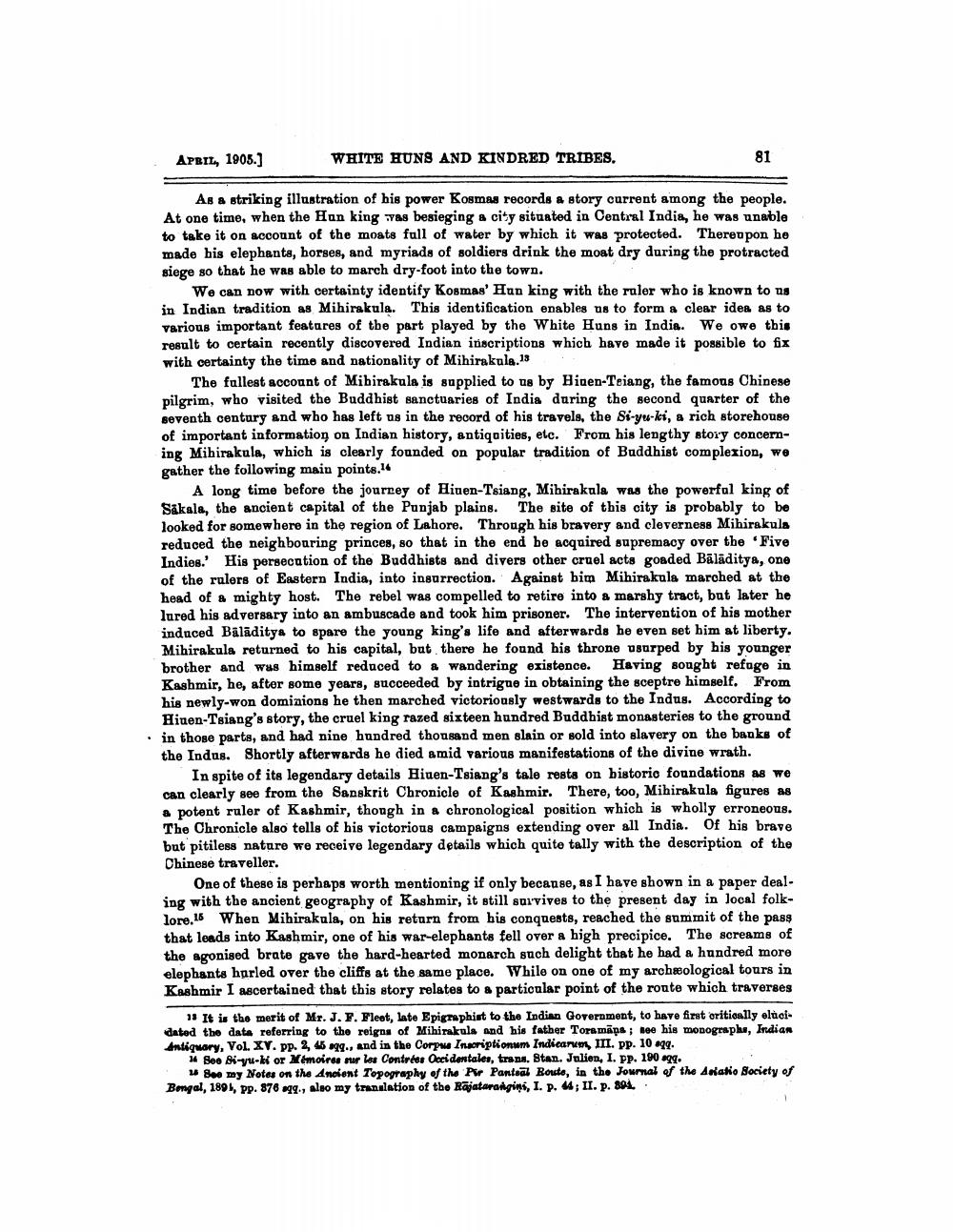________________
APRIL, 1905.]
WHITE HUNS AND KINDRED TRIBES,
As a striking illustration of his power Kosmas records a story current among the people. At one time, when the Han king was besieging a city situated in Central India, he was unable to take it on account of the moats full of water by which it was protected. Thereupon he made his elephants, horses, and myriads of soldiers drink the moat dry during the protracted siege so that he was able to march dry-foot into the town.
We can now with certainty identify Kosmas' Han king with the ruler who is known to us in Indian tradition as Mihirakula. This identification enables us to form a clear idea as to various important features of the part played by the White Huns in India. We owe this result to certain recently discovered Indian inscriptions which have made it possible to fix with certainty the time and nationality of Mihirakula.13
The fullest account of Mihirakula is supplied to us by Higen-Teiang, the famous Chinese pilgrim, who visited the Buddhist sanctuaries of India during the second quarter of the seventh century and who has left us in the record of his travels, the Si-yu-ki, a rich storehouse of important information on Indian history, antiquities, etc. From his lengthy story concerning Mihirakula, which is clearly founded on popular tradition of Buddhist complexion, we gather the following main points.14
A long time before the journey of Hiuen-Tsiang, Mihirakula was the powerful king of Såkals, the ancient capital of the Punjab plains. The site of this city is probably to be looked for somewhere in the region of Lahore. Through his bravery and cleverness Mihirakula reduced the neighbouring princes, so that in the end be acquired supremacy over the Five Indies. His persecution of the Buddhists and divers other cruel acts goaded Bālāditya, one of the rulers of Eastern India, into insurrection. Against bim Mihirakula marched at the head of a mighty host. The rebel was compelled to retire into a marshy tract, but later he lured his adversary into an ambuscade and took him prisoner. The intervention of his mother induced Balāditya to spare the young king's life and afterwards he even set him at liberty. Mihirakula returned to his capital, but there he found his throne usurped by his younger brother and was himself reduced to & wandering existence. Having songht refuge in Kashmir, he, after some years, succeeded by intrigue in obtaining the sceptre himself. From his newly-won dominions he then marched victoriously westwards to the Indus. According to Hiten-Tsiang's story, the cruel king razed sixteen hundred Buddhist monasteries to the ground in those parts, and had nine hundred thousand men slain or sold into slavery on the banks of the Indus. Shortly afterwards he died amid various manifestations of the divine wrath.
In spite of its legendary details Hiuen-Tsiang's tale rests on historie foundations as we can clearly see from the Sanskrit Chronicle of Kashmir. There, too, Mihirakula figures as a potent ruler of Kashmir, though in a chronological position which is wholly erroneous. The Chronicle also tells of his victorious campaigns extending over all India. Of his brave but pitiless nature we receive legendary details which quite tally with the description of the Chinese traveller.
One of these is perhaps worth mentioning if only because, as I have shown in a paper dealing with the ancient geography of Kashmir, it still survives to the present day in local folklore. When Mihirakula, on his return from his conquests, reached the summit of the pass that leads into Kashmir, one of his war-elephants fell over a high precipice. The screams of the agonised brate gave the hard-hearted monarch such delight that he had a hundred more elephants hurled over the cliffs at the same place. While on one of my archeological tours in Kashmir I ascertained that this story relates to a particular point of the route which traverses
11 It is the merit of Mr. J. F. Flest, late Epigraphist to the Indian Government, to have first oritically elucidated the data referring to the reigns of Mihirakula and his father Torsmāps; Nee his monographs, Indian Antiquary, Vol. XV. pp. 2, 45999., and in the Corpus Inscriptionum Indicarum, III. pp. 10.99.
4 See Si-yu-ki or Mémoires sur les Contrées Occidentales, trans. Stan. Julien, I. Pp. 190 699.
See my Notes on the Ancient Topography of the Pir Pantaal Route, in the Journal of the Anato Society of Bengal, 1891, pp. 876 99., also my translation of the Rājatarangins, I. p. 44; II. p. 894.




